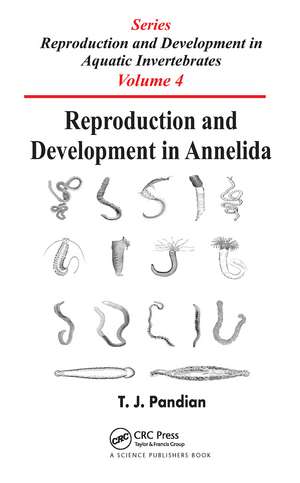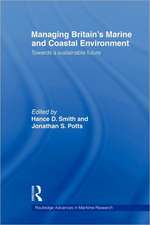Reproduction and Development in Annelida: Reproduction and Development in Aquatic Invertebrates
Autor T. J. Pandianen Limba Engleză Paperback – 31 mar 2021
Regenerative potency of annelids ranges from an organ to an entire worm from a single ‘seminal’ segment. The head, tail and both together can be regenerated 21, 42 and 20 times, respectively. However, the potency is limited to ~1% of polychaetes and < 2% of oligochaetes. In oligochaetes, the chloragogue temporally separates regeneration and reproduction but sedentary polychaetes undertake them together at the reduced reproductive output. Only 79 polychaete and 111 oligochaete species have the potency for clonal reproduction. Within families, the potency ranges from 2% in spionids to 54% in naidids. Epitoky, a spectacular and unique phenomenon, involves the transformation from benthic to meroplanktonic reproductive morphism. It occurs in 106 errant polychaete species. The larger glycerides, nereidids and eunicids use muscular energy to climb < 50 m vertical distance. But the small phyllodocids and cteniodrilids may reduce buoyancy to climb 1,000–4,000 m vertical distance.
Heterogamatic sex determination is reported to occur only in six polychaete species, although karyotype is known for 83 annelid species. In temperate polychaetes, a dozen neuroendocrines, arising mostly from the ‘brain’ regulates reproductive cycle. A complete chapter devoted to vermiculture, (i) recognizes the fast-growing candidate species, (ii) distinguishes 'layers' from 'brooders', (iii) indicates that the harvest of oligochaetes may reduce the input of nitrogenous fertilizer in the ricefield, and (iv) explores the scope for increasing wealth from waste.
| Toate formatele și edițiile | Preț | Express |
|---|---|---|
| Paperback (1) | 436.14 lei 6-8 săpt. | |
| CRC Press – 31 mar 2021 | 436.14 lei 6-8 săpt. | |
| Hardback (1) | 1220.94 lei 6-8 săpt. | |
| CRC Press – 4 feb 2019 | 1220.94 lei 6-8 săpt. |
Preț: 436.14 lei
Nou
Puncte Express: 654
Preț estimativ în valută:
83.46€ • 87.54$ • 69.48£
83.46€ • 87.54$ • 69.48£
Carte tipărită la comandă
Livrare economică 01-15 aprilie
Preluare comenzi: 021 569.72.76
Specificații
ISBN-13: 9780367780326
ISBN-10: 0367780321
Pagini: 292
Dimensiuni: 156 x 234 x 15 mm
Greutate: 0.45 kg
Ediția:1
Editura: CRC Press
Colecția CRC Press
Seria Reproduction and Development in Aquatic Invertebrates
Locul publicării:Boca Raton, United States
ISBN-10: 0367780321
Pagini: 292
Dimensiuni: 156 x 234 x 15 mm
Greutate: 0.45 kg
Ediția:1
Editura: CRC Press
Colecția CRC Press
Seria Reproduction and Development in Aquatic Invertebrates
Locul publicării:Boca Raton, United States
Cuprins
1. Introduction.
2. Sexual Reproduction.
3. Regeneration.
4. Asexual Reproduction.
5. Epitoky.
6. Sex Determination.
7. Sex Differentiation.
8. Culture of Annelids.
9. Summary and New Findings References.
2. Sexual Reproduction.
3. Regeneration.
4. Asexual Reproduction.
5. Epitoky.
6. Sex Determination.
7. Sex Differentiation.
8. Culture of Annelids.
9. Summary and New Findings References.
Notă biografică
T. J. Pandian, M.Sc., PhD, Dr.rer.net, D.Sc., is the Senior Scientist at the National Science Academy in Madurai, India. He has published several books over the past years in the 'Reproduction and Development in Aquatic Invertebrates' series. The theme of this series is sexuality, sex determination and sex differentiation in fish. In addition, he has published over 200 original publications and guided numerous students in obtaining their Ph.D.
Descriere
Reproduction and Development in Annelida will offer a comprehensive update to our knowledge of the reproduction and development of annelids. The book will include a chapter on epitoky, which is unique to some errant polychaetes and has attracted the attention of a large number of zoologists through the years.























